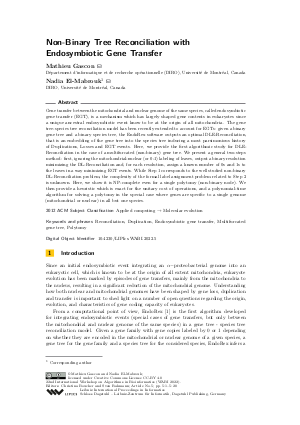Non-Binary Tree Reconciliation with Endosymbiotic Gene Transfer
Authors Mathieu Gascon, Nadia El-Mabrouk
-
Part of:
Volume:
22nd International Workshop on Algorithms in Bioinformatics (WABI 2022)
Part of: Series: Leibniz International Proceedings in Informatics (LIPIcs)
Part of: Conference: International Conference on Algorithms for Bioinformatics (WABI) - License:
 Creative Commons Attribution 4.0 International license
Creative Commons Attribution 4.0 International license
- Publication Date: 2022-08-26
File

PDF
LIPIcs.WABI.2022.5.pdf
- Filesize: 0.97 MB
- 20 pages
Document Identifiers
Subject Classification
ACM Subject Classification
- Applied computing → Molecular evolution
Keywords
- Reconciliation
- Duplication
- Endosymbiotic gene transfer
- Multifurcated gene tree
- Polytomy
Metrics
- Access Statistics
-
Total Accesses (updated on a weekly basis)
0Document
0Metadata
Abstract
Gene transfer between the mitochondrial and nuclear genome of the same species, called endosymbiotic gene transfer (EGT), is a mechanism which has largely shaped gene contents in eukaryotes since a unique ancestral endosymbiotic event know to be at the origin of all mitochondria. The gene tree-species tree reconciliation model has been recently extended to account for EGTs: given a binary gene tree and a binary species tree, the EndoRex software outputs an optimal DLE-Reconciliation, that is an embedding of the gene tree into the species tree inducing a most parsimonious history of Duplications, Losses and EGT events. Here, we provide the first algorithmic study for DLE-Reconciliation in the case of a multifurcated (non-binary) gene tree. We present a general two-steps method: first, ignoring the mitochondrial-nuclear (or 0-1) labeling of leaves, output a binary resolution minimizing the DL-Reconciliation and, for each resolution, assign a known number of 0s and 1s to the leaves in a way minimizing EGT events. While Step 1 corresponds to the well studied non-binary DL-Reconciliation problem, the complexity of the formal label assignment problem related to Step 2 is unknown. Here, we show it is NP-complete even for a single polytomy (non-binary node). We then provide a heuristic which is exact for the unitary cost of operations, and a polynomial-time algorithm for solving a polytomy in the special case where genes are specific to a single genome (mitochondrial or nuclear) in all but one species.
Cite As Get BibTex
Mathieu Gascon and Nadia El-Mabrouk. Non-Binary Tree Reconciliation with Endosymbiotic Gene Transfer. In 22nd International Workshop on Algorithms in Bioinformatics (WABI 2022). Leibniz International Proceedings in Informatics (LIPIcs), Volume 242, pp. 5:1-5:20, Schloss Dagstuhl – Leibniz-Zentrum für Informatik (2022)
https://doi.org/10.4230/LIPIcs.WABI.2022.5
BibTex
@InProceedings{gascon_et_al:LIPIcs.WABI.2022.5,
author = {Gascon, Mathieu and El-Mabrouk, Nadia},
title = {{Non-Binary Tree Reconciliation with Endosymbiotic Gene Transfer}},
booktitle = {22nd International Workshop on Algorithms in Bioinformatics (WABI 2022)},
pages = {5:1--5:20},
series = {Leibniz International Proceedings in Informatics (LIPIcs)},
ISBN = {978-3-95977-243-3},
ISSN = {1868-8969},
year = {2022},
volume = {242},
editor = {Boucher, Christina and Rahmann, Sven},
publisher = {Schloss Dagstuhl -- Leibniz-Zentrum f{\"u}r Informatik},
address = {Dagstuhl, Germany},
URL = {https://drops.dagstuhl.de/entities/document/10.4230/LIPIcs.WABI.2022.5},
URN = {urn:nbn:de:0030-drops-170390},
doi = {10.4230/LIPIcs.WABI.2022.5},
annote = {Keywords: Reconciliation, Duplication, Endosymbiotic gene transfer, Multifurcated gene tree, Polytomy}
}
Author Details
- Département d'informatique et de recherche opérationnelle (DIRO), Université de Montréal, Canada
References
-
Y. Anselmetti, N. El-Mabrouk, M. Lafond, and A. Ouangraoua. Gene tree and species tree reconciliation with endosymbiotic gene transfer. Bioinformatics, 37(SI-1):i120-i132, 2021.

-
W.C. Chang and O. Eulenstein. Reconciling gene trees with apparent polytomies. In D.Z. Chen and D. T. Lee, editors, Proceedings of the 12th Conference on Computing and Combinatorics (COCOON), volume 4112 of Lecture Notes in Computer Science, pages 235-244, 2006.

-
C. Colijn and G. Plazzotta. A metric on phylogenetic tree shapes. Systematic Biology, 67(1):113-126, 2018.

-
D. Durand, B.V. Haldórsson, and B. Vernot. A hybrid micro-macroevolutionary approach to gene tree reconstruction. Journal of Computational Biology, 13:320-335, 2006.

-
N. El-Mabrouk and E. Noutahi. Bioinformatics and Phylogenetics: Seminal Contributions of Bernard Moret, chapter Gene Family Evolution - An Algorithmic Framework, pages 87-119. Springer International Publishing, t. warnow edition, 2019.

-
M.W. Hahn. Bias in phylogenetic tree reconciliation methods: implications for vertebrate genome evolution. Genome Biology, 8(7):R141, 2007.

-
S. Kannan, I. Rogozin, and E. Koonin. MitoCOGs: clusters of orthologous genes from mitochondria and implications for the evolution of eukaryotes. BMC Evolutionary Biology, 14(11):1-16, 2014.

-
M. Lafond, N. El-Mabrouk, K.T. Huber, and V. Moulton. The complexity of comparing mutiply-labelled trees by extending phylogenetic-tree metrics. Theoretical Computer Science, 760:15-34, 2018.

-
M. Lafond, E. Noutahi, and N. El-Mabrouk. Efficient Non-Binary Gene Tree Resolution with Weighted Reconciliation Cost. In Roberto Grossi and Moshe Lewenstein, editors, 27th Annual Symposium on Combinatorial Pattern Matching (CPM 2016), volume 54 of Leibniz International Proceedings in Informatics (LIPIcs), pages 14:1-14:12, Dagstuhl, Germany, 2016. Schloss Dagstuhl-Leibniz-Zentrum fuer Informatik.

-
M. Lafond, K.M. Swenson, and N. El-Mabrouk. An optimal reconciliation algorithm for gene trees with polytomies. In LNCS, volume 7534 of WABI, pages 106-122, 2012.

-
J. Sabir, R. Jansen, D. Arasappan, et al. The nuclear genome of Rhazya stricta and the evolution of alkaloid diversity in a medically relevant clade of Apocynaceae. Scientific Reports, 6(1):33782, 2007.

-
Y. Zheng and L. Zhang. Reconciliation with nonbinary gene trees revisited. J. ACM, 64(4), August 2017.

